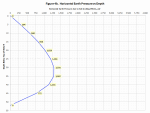Soil Arching - Braced Excavations

Description
This spreadsheet will calculate the horizontal earth pressure exerted on a braced excavation using Soil Arching Theory as proposed by Richard L. Handy (1985).
Calculation Reference
Soil Mechanics
Geotechnics
Engineering Geology
Soil arching, also known as stress arching, is a phenomenon in which soil transfers loads laterally to stiffer elements or adjacent soil, reducing the vertical stress acting on a weaker or compressible layer. Richard L. Handy proposed a soil arching theory in 1985 that aimed to explain the mechanics behind this phenomenon and provide a basis for understanding its effects on soil-structure interaction.
Handy's theory is based on the observation that soil particles can form stable arches under certain conditions, such as when lateral confinement is provided. When arching occurs, the vertical stresses within the compressible layer are redistributed, and the soil arches transfer some of the load to the adjacent, stiffer soil or structural elements.
The main principles of Handy's soil arching theory can be summarized as follows:
-
Arching mechanism: Soil arching occurs when a compressible soil layer is sandwiched between stiffer soil layers or structural elements. The load from the overlying soil is transferred laterally to the stiffer elements, reducing the vertical stress on the compressible layer.
-
Mobilization of soil arching: Soil arching is mobilized when the deformation of the compressible layer reaches a certain threshold. As the layer deforms, it creates a lateral confinement that allows soil arches to form and transfer loads to the adjacent, stiffer soil or structural elements.
-
Factors affecting soil arching: Several factors influence the development and effectiveness of soil arching, including soil properties (e.g., stiffness, strength, and dilatancy), geometry of the compressible layer and adjacent elements, and the magnitude and distribution of the applied loads.
-
Consequences of soil arching: Soil arching can have both beneficial and detrimental effects on soil-structure interaction. On one hand, it can reduce the loads on buried structures or foundations, leading to smaller deformations and lower bearing pressures. On the other hand, it can increase the lateral loads on retaining walls or excavation support systems, potentially compromising their stability.
Handy's soil arching theory has been widely used in geotechnical engineering practice to analyze the behavior of various soil-structure systems, such as piled embankments, buried pipes, and retaining walls. However, it is important to note that the actual soil arching behavior can be more complex than the idealized conditions assumed in the theory. Therefore, it is essential to consider site-specific factors, perform detailed analyses, and consult with experienced geotechnical engineers when applying Handy's soil arching theory in practice.
Calculation Preview
Full download access to any calculation is available to users with a paid or awarded subscription (XLC Pro).
Subscriptions are free to contributors to the site, alternatively they can be purchased.
Click here for information on subscriptions.





